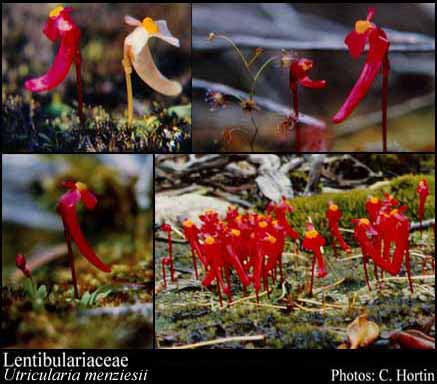- Reference
- Fl.Paris 1:26 (1808)
- Name Status
- Current

Scientific Description
Common name. Bladderwort Family.
Habit and leaf form. Herbs. ‘Normal’ plants, or switch-plants, or plants of very peculiar form; Utricularia often exhibiting no clear distinction between stems, roots and leaves, the stem bearing photosynthetic appendages equipped with animal-trapping bladders. Leaves well developed, or absent (some Utricularia species). Plants with roots, or rootless (floating Utricularia species); ‘carnivorous’. Trapping mechanism active, or passive. The traps in the form of minute (submerged) bladders (Utricularia, Polypompholyx), or constituted by sticky leaf glands, associated with subsequent, slow enclosure of the prey by movement of the blade (Pinguicula), or consisting of ‘pitchers’ (Genlisea). Perennial; plants with a basal concentration of leaves, or with neither basal nor terminal concentrations of leaves. When rooted/non-aquatic, self supporting, or epiphytic. Hydrophytic, or helophytic; when aquatic, free floating, or rooted. Leaves of hydrophytes submerged, or emergent. Heterophyllous (often, with both ‘modified’ and ‘normal’ leaves), or not heterophyllous. Leaves alternate; spiral; when identifiable ‘herbaceous’; petiolate, or subsessile; non-sheathing; when identifiable simple. Leaf blades entire; pinnately veined. Leaves without stipules; without a persistent basal meristem. Stem anatomy. Nodes unilacunar. Secondary thickening absent.
Reproductive type, pollination. Fertile flowers hermaphrodite. Unisexual flowers absent. Plants hermaphrodite. Entomophilous.
Inflorescence and flower features. Flowers solitary (sometimes), or aggregated in ‘inflorescences’; in racemes and in spikes. The terminal inflorescence unit racemose. Inflorescences scapiflorous. Flowers bracteate, or ebracteate; small to medium-sized; very irregular; zygomorphic. The floral asymmetry involving the perianth and involving the androecium. Flowers basically 5 merous; cyclic; tetracyclic, or pentacyclic. Free hypanthium absent. Hypogynous disk absent. Perianth with distinct calyx and corolla; 4–10; 2 -whorled, or 3 -whorled; isomerous, or anisomerous. Calyx 2, or 4–5 (lobed); 1 -whorled, or 2 -whorled (Polypompholyx); gamosepalous; blunt-lobed; imbricate, or open in bud; bilabiate (often), or unequal but not bilabiate; persistent; at least theoretically with the median member posterior. Corolla 5 (at least theoretically), or 2 (sometimes, ostensibly); 1 -whorled; gamopetalous; imbricate; bilabiate (the upper, posterior lip of two joined members, the lower of three and commonly personate); spurred (or saccate, anteriorly). Androecium 2, or 4. Androecial members adnate (to the base of the corolla tube); free of one another; 1 -whorled. Androecium exclusively of fertile stamens, or including staminodes. Staminodes if present, 2 (posterior). Stamens 2 (the anterior pair); reduced in number relative to the adjacent perianth; more or less theoretically oppositisepalous; all alternating with the corolla members. Anthers connivent; dorsifixed; dehiscing via longitudinal slits; unilocular, or unilocular to bilocular (transversely constricted); tetrasporangiate. Gynoecium 2 carpelled (the posterior member represented by its reduced stigma). The pistil 1 celled. Carpels reduced in number relative to the perianth. Gynoecium syncarpous; synstylovarious; superior. Ovary unilocular; 1 locular. Gynoecium median (the stigmas one posterior, the other anterior). Ovary sessile. Gynoecium non-stylate, or stylate. Styles 1; apical. Stigmas 1–2 (the posterior lobe more or less abortive); wet type; papillate; Group III type. Placentation free central. Ovules in the single cavity (2–)5–100 (i.e. to ‘many’); funicled, or sessile, or sunken in the placenta (often); non-arillate; anatropous.
Fruit and seed features. Fruit non-fleshy; dehiscent, or indehiscent; a capsule, or capsular-indehiscent. Capsules valvular (2–4 valves), or circumscissile, or splitting irregularly. Seeds non-endospermic. Embryo rudimentary at the time of seed release; chlorophyllous (1/1); straight. Seedling. Germination phanerocotylar.
Physiology, biochemistry. Aluminium accumulation demonstrated (in Utricularia).
Geography, cytology, number of species. World distribution: cosmopolitan. X = 6, 8, 9, 11, 21. 245 species.